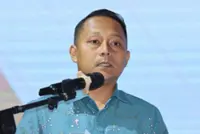Team effort: Evangelene (far left, front row) and her friends posing with their completed experiment as part of the WISTEM2D programme.
“ARE you sure you’re ready for that stressful STEM (science, technology, engineering and mathematics) life?”
This question, asked by a concerned relative when I shared my decision to pursue the science stream for upper secondary school, surprisingly became the spark that ignited my journey.
I did hesitate at first. The stories I had heard from seniors “suffering” in the science stream – particularly because of subjects like Additional Mathematics and Biology – intimidated me.
The thought of entering a stream that might demand my utmost commitment felt overwhelming. Was I really cut out for the challenges, constant learning and all-nighters? I wondered.
But the more I thought about it, the more my curiosity and determination to prove others wrong outweighed my fear.
At the start of Form Four, each teacher who came into class during the first week warned us repeatedly that we could not afford to slack off in the science stream.
What a way to start the first week of school, I thought. But rather than discouraging me, it only fuelled my determination to stay the course for my Sijil Pelajaran Malaysia exams.
While there were many challenges along the way, one experience in particular renewed my passion for STEM.
It was the 2024 Women in Science, Technology, Engineering, Math, Manufacturing and Design (WISTEM2D) Sustainable Innovation Challenge, which my class teacher encouraged us to join. She emphasised that it would be a valuable experience, especially for science stream students.
Intrigued, my friends and I decided to participate. The challenge required us to think innovatively and conduct research on how we could restore Malaysia’s urban ecosystem using the STEM2D concept.
As I conducted research, I realised how fascinating it is that with today’s advancements in technology and equipment, we could make a significant environmental impact if we used them wisely.
Did you know that integrating the Geographic Information System (GIS) – a computer system for capturing, storing, checking and displaying geographical data – can help determine the best locations for buildings and infrastructure, ensuring optimal urban development? Amazing, right?
My team of five from SMK Assunta, Selangor, came up with the idea of creating an agroforestry-inspired green roof to help restore the urban ecosystem, using the GIS to plan suitable locations for the project. We emerged as the first runner-up in the challenge.
After this rewarding outing, I felt more motivated than ever in my studies. I realised there is more to STEM than meets the eye.
Going into Form Five in the coming school year, I will continue to study relentlessly. In the future, I plan to pursue forensic science. This goal has been one of my main sources of motivation, helping me push through stress and worries.
Whenever I face tough moments as a science stream student, I also remind myself of the joy of discovery and the thrill of solving an Additional Mathematics problem.
If someone were to ask me that same question posed by my relative again, I would confidently say, “Yes!”
Looking back, that question wasn’t a warning; it was a challenge.
To all my fellow science stream students, do not be afraid or worried about how things will turn out. Even if the answer to an Additional Mathematics question might span a whole page, or you have to memorise all 15 chapters for a Biology exam, know that this hard work will pay off one day.
Let us not dwell on the past or the future but focus on what we can achieve today for the better!
I hope my journey helps someone break free from the stereotypes and fears surrounding the science stream and STEM. If you are considering it, go for it – leave no regrets!
Evangelene, 17, a student in Selangor, is a participant of the BRATs Young Journalist Programme run by The Star’s Newspaper-in-Education (Star-NiE) team. For updates on the BRATs programme, go to facebook.com/niebrats.
With the theme of the article in mind, carry out the following english language activities.
1 List the nouns and adjectives that come to mind when you hear the term “STEM”. do these words reflect a positive or negative attitude towards the field?
Compare your list with your friends’ and discuss ways to develop a more positive attitude.
2 Choose a STEM topic and imagine explaining it to primary school pupils. How would you simplify the concept for them?
In groups of four, brainstorm creative ways to present it, and then role-play with your classmates as the pupils.
The Star’s Newspaper-in-Education (Star-NiE) programme promotes the use of English language in primary and secondary schools nationwide. For Star-NiE enquiries, email starnie@thestar.com.my.







